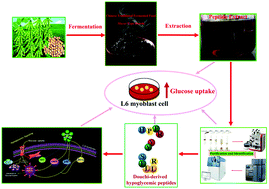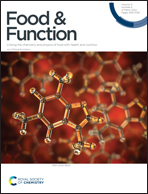Purification and characterization of hypoglycemic peptides from traditional Chinese soy-fermented douchi†
Abstract
Douchi is a popular soy-fermented food that originated in China with documented hypoglycemic effects. However, the responsible molecules and the mechanism underlying their beneficial effects remain unclear. Therefore, in this study, we aimed to identify the responsible peptide(s) in douchi. A peptide extract of douchi was isolated step-wise by the C18 Sep-Pak technique, size exclusion chromatography, and semi-preparative liquid chromatography, and then the peptides were sequenced by UPLC-MS/MS. A total of 21 peptides were identified, of which three peptides, P3 (HPFR), P5 (VY), and P7 (SFLLR), were shown to improve glucose uptake in L6 cells. Both P5 and P7 increased glucose transporter 4 (GLUT4) translocation via the activation of AMPK and MAPK signaling pathways, but not the insulin-signaling pathway; adding an AMPK or an MAPK inhibitor prevented P5 or P7-induced glucose uptake as well as AMPK and MAPK activation. Our study showed that P5 and P7 could promote glucose uptake via AMPK and MAPK signaling pathways. In this study, two hypoglycemic peptides from douchi have been characterized for the first time.



 Please wait while we load your content...
Please wait while we load your content...